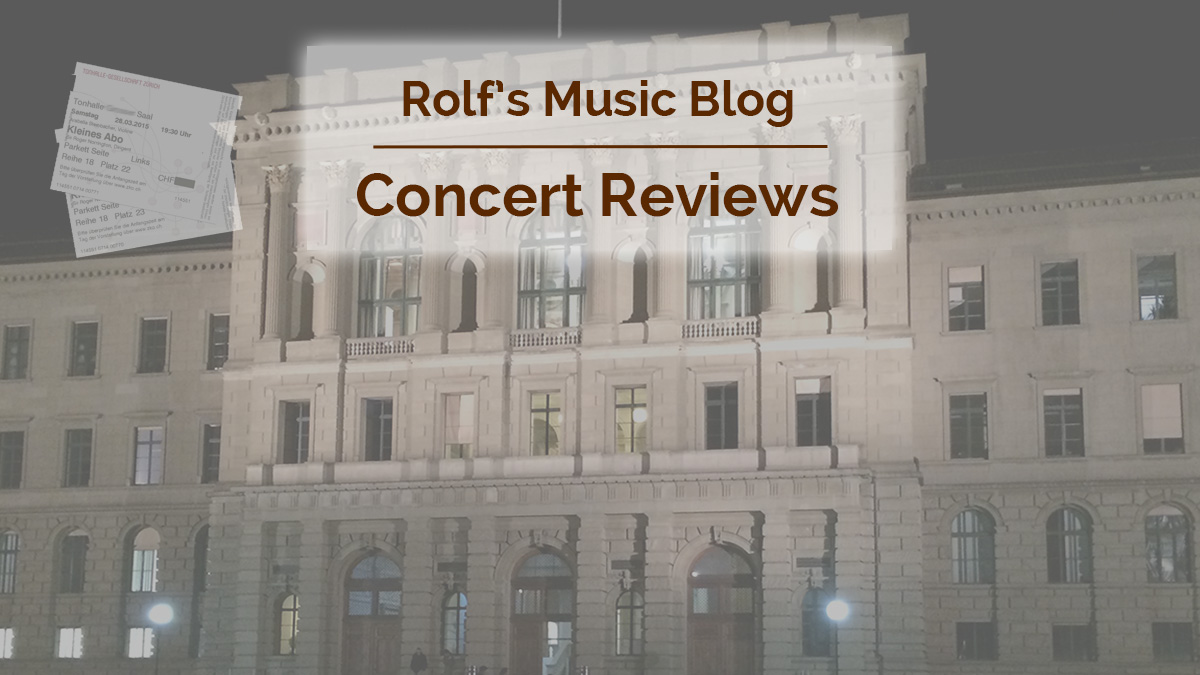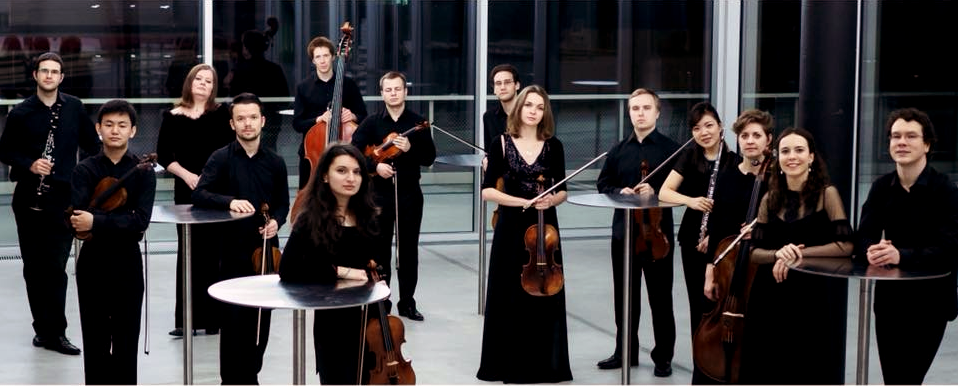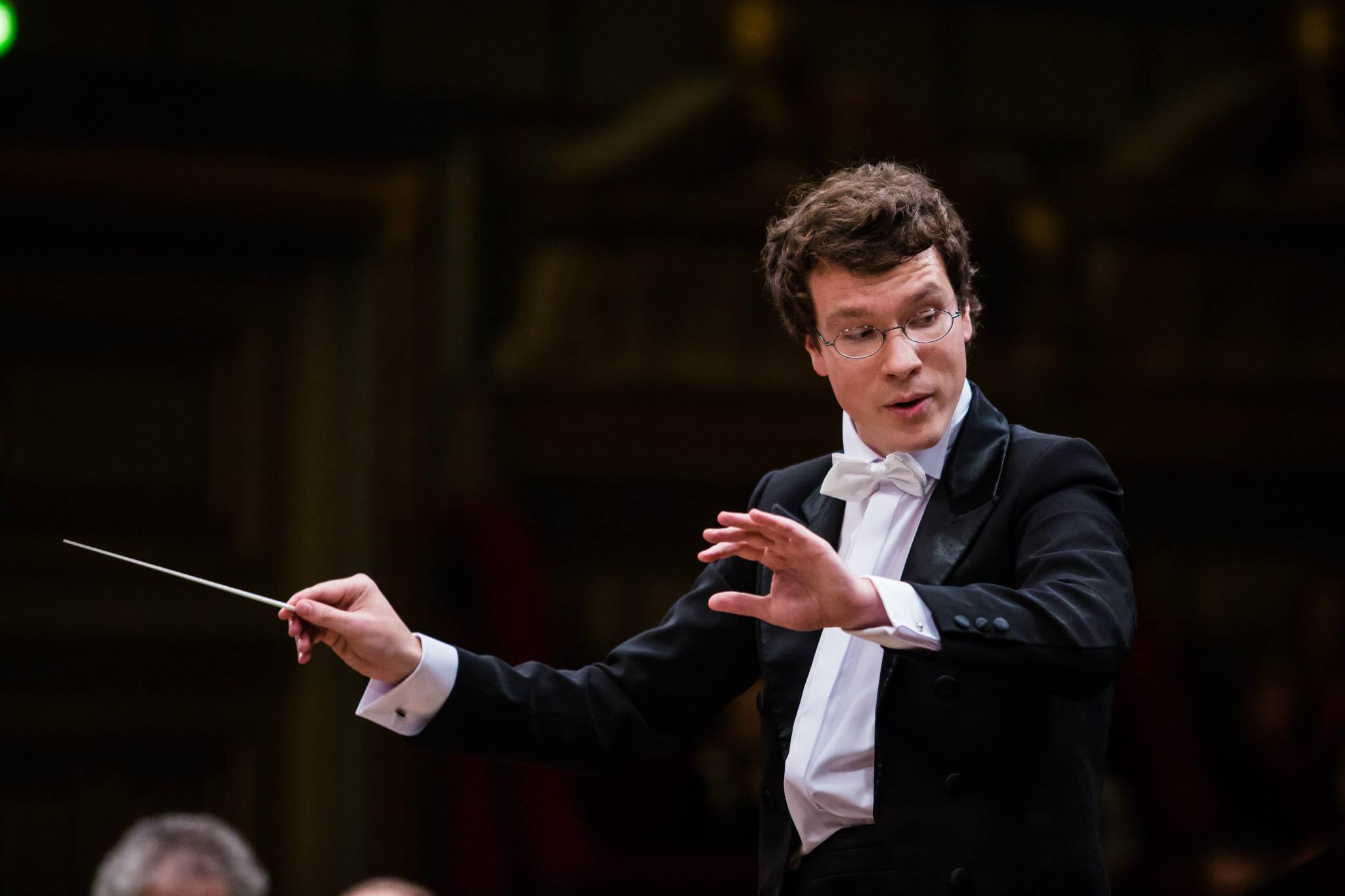Andreas Janke, Sergey Simakov / Giraud Ensemble
Tchaikovsky / Bernstein
Auditorium Maximum, ETH Zurich, 2018-01-30

2018-02-09 — Original posting
Table of Contents
Introduction
This was the last concert in the 2017/2018 season of “Musik an der ETH“, held in the Auditorium maximum of the Swiss Federal Institute of Technology in Zurich. As a concert venue, this is a rather neutral, factual lecture theater, with barely enough space for an orchestra on the “podium”. However, as a lecture room, it offers excellent visibility to a fair number of people, and also acoustically, the quality is about the same for all seats, even though there is no reverberation at all.
The Orchestra
The Giraud Ensemble is a chamber music ensemble / orchestra that emerged in 2015. The young musicians are all at the beginning of their career. The international ensemble is giving concerts in Switzerland and Germany, in formations from a quintet up to a fair-size chamber orchestra with 40 members. The name refers to the Belgian poet Albert Giraud (1860 – 1929), author of the libretto for the melodrama “Pierrot Lunaire“, op.21 by Arnold Schönberg (1874 – 1951). Schönberg’s composition stood at the beginning of the ensemble, and it also shaped the initial composition of the ensemble. The Giraud Ensemble now performs a broad range of music, from baroque to contemporary.
I counted instrumentalists playing 5 + 4 violins, 3 violas, 3 cellos, 2 double basses, piano—plus 5 percussionists. With the exception of the cellists, all string players were performing standing. While I think this is the way in which the Giraud Ensemble usually performs, it probably was a necessity here, given the limited available space.
The Conductor
The conductor Sergey Simakov squeezed himself into the narrow space between the ensemble and the audience. For the second composition, he even stood behind the first row of seats, to allow for enough space for the soloist. In the years 2003 – 2010, Simakov (*1985) studied conducting at the Kazan Conservatory, with Fuat Mansurov (1928 – 2010). He then went on to study at the Hochschule für Musik in Freiburg, later took master classes with notable conductors.
Tchaikovsky: Serenade for Strings in C major, op.48
Pyotr Ilyich Tchaikovsky (1840 – 1893) wrote his Serenade for strings in C major, op.48 in 1880. Although in the first movement, the composer intended to imitate Mozart’s style, at the same time he added a remark in the score, to the effect of “the more string players, the better”. Clearly, it is a late-romantic composition throughout. It features four movements:
- Pezzo in forma di sonatina: Andante non troppo — Allegro moderato
- Valse: Moderato — Tempo di valse
- Élégie: Larghetto elegiaco
- Finale (Tema russo): Andante — Allegro con spirito
I have posted a review on a performance of this serenade, in a concert in the Schauspielhaus in Zurich on 2017-03-26.
The Performance
I. Pezzo in forma di sonatina: Andante non troppo — Allegro moderato
The serenade started with a lot of emphasis—an emphasis on every single note, it seemed: very intense playing, impressive volume, nice, full string sound. Later, when the Andante non troppo part retracts into p, then pp, there was no degradation in the sound quality, the homogeneity. I really liked that the pp was with virtually no vibrato!
In the Allegro moderato part, the main motif had its third note (first in bars 38/39) shortened, almost to a quaver. That may seem in disagreement with the score, but it certainly takes away unnecessary weight, makes the piece sound lighter: this music is often enough heard overblown, with heavy legato (especially in traditional performances). the cello had a fairly virtuosic part, all in semiquavers: thanks to the generally light articulation, the three cellos had no problem making themselves heard. The same holds true for the pizzicato segments in the low strings.
In general, the coordination was excellent, the overall impression rather one of chamber music than from an orchestral performance. Naturally, in terms of homogeneity, the individual voices can’t compete with that of large(r) orchestras. On the other hand, in the smaller setting, one felt “closer to the action”, the playing had more of a “human touch”. Sure, with the small orchestra, one can hardly expect to hear the fff, even ffff (for the last chord) that the score asks for. I barely felt more than ff—but I don’t see this as detrimental at all: the performance did its best to follow Tchaikovsky’s dynamic annotations..
II. Valse: Moderato — Tempo di valse
Excellent, fluent tempo in the Valse movement, and an excellent waltz feeling, with the appropriate agogic swing, subtle rubato. And I liked those “suspended” fermatas, where Simakov appear to hold the note as long as possible! In this small formation, the trills and mordents stood out clearly and nicely. An excellent interpretation—it even received extra applause!
III. Élégie: Larghetto elegiaco
Here, I noted the careful dynamics, the careful shaping of dynamic arches. And the pizzicato (and later staccato triplet) accompaniment to the nice melodies in alternating voices was very nice. I liked the solo by three violas around [B] in the score: impressive volume, homogeneity (from only three instruments)—a “talking” voice, really! Another highlight was the morendo prior to Tempo I, and the careful shaping of the dynamics in the bars that follow. OK, in the soft parts, the slight excess in emphasis made some of the individual notes sound like belly notes.
On the other hand, the ending of that movement in pppp (!) was very nicely realized. One might think that that’s easy to do with such a small number of instruments. However, maintaining homogeneity in such softest playing can be a challenge, too (and the fewer instruments, the more homogeneity in sound is a challenge anyway!).
IV. Finale (Tema russo): Andante — Allegro con spirito
After the gentle Andante introduction (a nice invention!), the Allegro con spirito took off with a fluent tempo. It’s a rather virtuosic movement, challenging in maintaining clarity in the articulation of small note values. The orchestra mastered this fairly well, even though the pace was at the limit of what is doable without losing clarity (some of the semiquaver figures may have been a tad above the limit, though). Also the extensive pizzicato segments maintained excellent coordination.
Towards the end, Tchaikovsky momentarily returns to the theme of the first movement, prior to the joyful, almost frantic ending. Also this was well done, though ideally, I would occasionally have preferred a little more “power” / volume. That’s not just a trade-off with a small ensemble, but most likely also a consequence of the very dry acoustics.
In general: very well done, congrats!
Bernstein: Serenade after Plato’s “Symposion”
The Composition
Leonard Bernstein (1918 – 1990) wrote his Serenade for solo violin, harp, percussion and strings after Plato‘s “Symposion“ in 1954. The composition really is a highly virtuosic violin concerto. It is inspired by “Symposion” (Symposium), a key work by the ancient Greek philosopher Plato (around 428 – 347 B.C.). Bernstein’s Serenade is a series of five movements / dialogs about the topic of love, featuring seven prominent philosophers / poets of (before) Platon’s time:
- Phaedrus: Pausanias (Lento — Allegro marcato)
- Aristophanes (Allegretto)
- Eryximachus, the Doctor (Presto)
- Agathon (Adagio)
- Socrates: Alcibiades (Molto tenuto — Adagio — Allegro molto vivace)
Challenges
Bernstein takes up elements from Jazz (quite heavily, in the rhythm, obviously), but also from Jewish singing and other styles of the mid-20th century. The Serenade really is an intricate violin concerto, with serious challenges not just in virtuosic speed, double-stop playing, flageolet and straight very high pitch playing, left hand pizzicato (occasionally), but primarily rhythmically, and even more so in intonation. In the composition of the serenade, Bernstein relied upon the help of violinist Isaac Stern (1920 – 2001), who edited the solo part and did the fingering. This may explain the presence of many of the intricate / advanced features in the solo part.
The Soloist
The violinist Andreas Janke (*1983) has been first concertmaster in the Tonhalle Orchestra Zurich since 2006. He is of German-Japanese descent and grew up in Munich. He received the main part of his violin education at the Mozarteum Salzburg, with Igor Ozim (1931 – 2024). Andreas Janke is also a gifted chamber musician, and as such, most notably a member of the Oliver Schnyder Trio. Since 2013, Janke is teaching at the ZHdK in Zurich (Zurich University of the Arts).
In preparation for this concert (and for writing this review), I watched a limited number of performances by renowned artists, through YouTube. In all these performances, most soloists performed the serenade with the help of sheet music. Andreas Janke played it by heart, which is an impressive achievement by itself, considering the rhythmic intricacies of the solo part.
The Orchestral Setting
With the soloist playing in the center of the small orchestral semi-circle, Sergey Simakov actually conducted this from behind the (empty) first row of seats. This may have looked a bit strange—but who really cares? More importantly, the spatial and instrumental setting did not reproduce the exact orchestral configuration that the score asks for. Yes, it is a serenade. However, typical performances involve a full_size symphony orchestra. Working with fewer string players of course gives the soloist better visibility, so may be an advantage. Overall, the composer probably envisaged an orchestra with more volume and power (which would definitely not fit the space in this venue).
Bernstein’s percussion parts were adequately covered here, I think. However, substituting a piano for a harp implied a certain degree of abstraction. Fortunately, the harp part is by far not as prominent as the violin solo. Hence, that’s a restriction that one can live with.
I. Phaedrus: Pausanias
Lento
In some interpretations, the beginning of the concerto (the Lento part of the movement) strongly reminds me of specific, meditative types of religious, Jewish singing (prayers? I lack the education in Jewish culture to name specifics here). In other interpretations, that specific character is less pronounced, or not present at all. I think that special “Jewish coloring” is a combination of meditative tempo, combined with expressive legato playing, and strong agogics. As for the expressivity, though, one should keep in mind that Bernstein writes “p, simply, molto legato, senza portamento“.
Andreas Janke’s playing was unpretentious (as was his appearance) and did not exhibit that much of that “Jewish tone”. At least initially, the emotions remained controlled, possibly an impression that was reinforced through the dry acoustics. It seemed to take him a few bars to be “in” the performance—in the acoustics of this venue, the soloist is extremely exposed, the smallest impurity is immediately obvious. After this introduction, however, Janke’s intonation was very firm and clean—throughout the entire concerto, and up to the highest range: excellent! Of course, the acoustics and the setting not only made the solo very exposed, it also gave the soloist instant, clear feedback and was likely helpful in maintaining intonation purity.
Allegro marcato
Here, the music sounded very much like chamber music, especially of course in the intimate segments. The soloist not only kept the intonation amazingly clean, he also was very firm in the rhythm. While the music sounds catchy, often is full of drive and momentum, a look into the score reveals that it is anything but easy. It requires extreme rhythmic firmness. Also, it most likely requires the soloist also to know the outline of the orchestral accompaniment inside out, when playing by heart. Already the violin part is tricky to read, with time signatures changing almost with every bar line. even just the beginning of the above Lento part reveals a sequence of 7/8 – 3/4 – 5/8 – 3/8 – 3/4 – 4/8 – 5/8 – 3/8 – 4/8 – 3/4 — all in the first 10 bars: that’s 1 signature per bar!
But also the orchestra sounded extremely firm and secure in the rhythm. The playing was focused and concentrated, throughout the concerto.
II. Aristophanes
Lots of double-stop playing in the solo part, with excellent intonation. the coordination was excellent in the lively scherzando parts. Overall, this movement felt very intimate, especially of course in the soft parts. Very nice music, with touching moments!
III. Eryximachus, the Doctor
This short, often ghastly Presto movement is very virtuosic—and brilliant, both as a composition, as well as in the performance: enthralling, excellent coordination, well done! For the listener, it is very hard to follow the rhythm at the given tempo. If there wasn’t a firm “backbone” from the percussion (snare drum, etc.), the music / rhythm would be utterly confusing.
IV. Agathon
Even though this movement is pensive and slow, it is rhythmically intricate, at least in reading the solo part. However, that’s exactly Bernstein’s intent: he wants to keep the melody line “in the air”, suspended, rhythmically. The orchestra does provide a solid base and helps the listener keeping the orientation.
The key challenge—mastered very well here—is in the intonation. This particularly applies to the cadenza with its tricky, extended double-stop passages. Intimate, cosy, touching music, talking of love, obviously! The warmth in this music persisted even though the solo part at times moves up into extreme heights (the “eternal snow” on the fingerboard and beyond, as cellists would say).
V. Socrates: Alcibiades
Molto tenuto
The movement begins with an elegiac, intense and broad segment, highly challenging in the intonation, but performed very well here, both in the solo part, as well as in the orchestra: very expressive! Well done, also in the solo cello (Seiji Yokota), which forms a duo with the solo violin.
Adagio
This is followed by an Adagio segment—very calm, really serenade-like, with a beautiful cantilena in the solo violin: to me, it felt like a night scenery—moonlight, a starry sky…
Allegro molto vivace
Very jazzy, full of syncopes, rhythmically intricate, sometimes appears to describe machinery, industrial environments, busy street life. But then, there are also scenes, where the music holds off, full of tension. And there are also humorous sections: catchy and very entertaining, for sure! And the final segment, the coda, is a sparkling, virtuosic, final firework.
Conclusion
The concert was s fascinating experience, with limitations mainly through the space limitations, the somewhat frugal lecture hall atmosphere, and the dry acoustics. The playing, however, was at absolutely professional level: an excellent orchestra in the hands of a competent conductor—and an excellent soloist, of course. Thanks for the interesting music!












